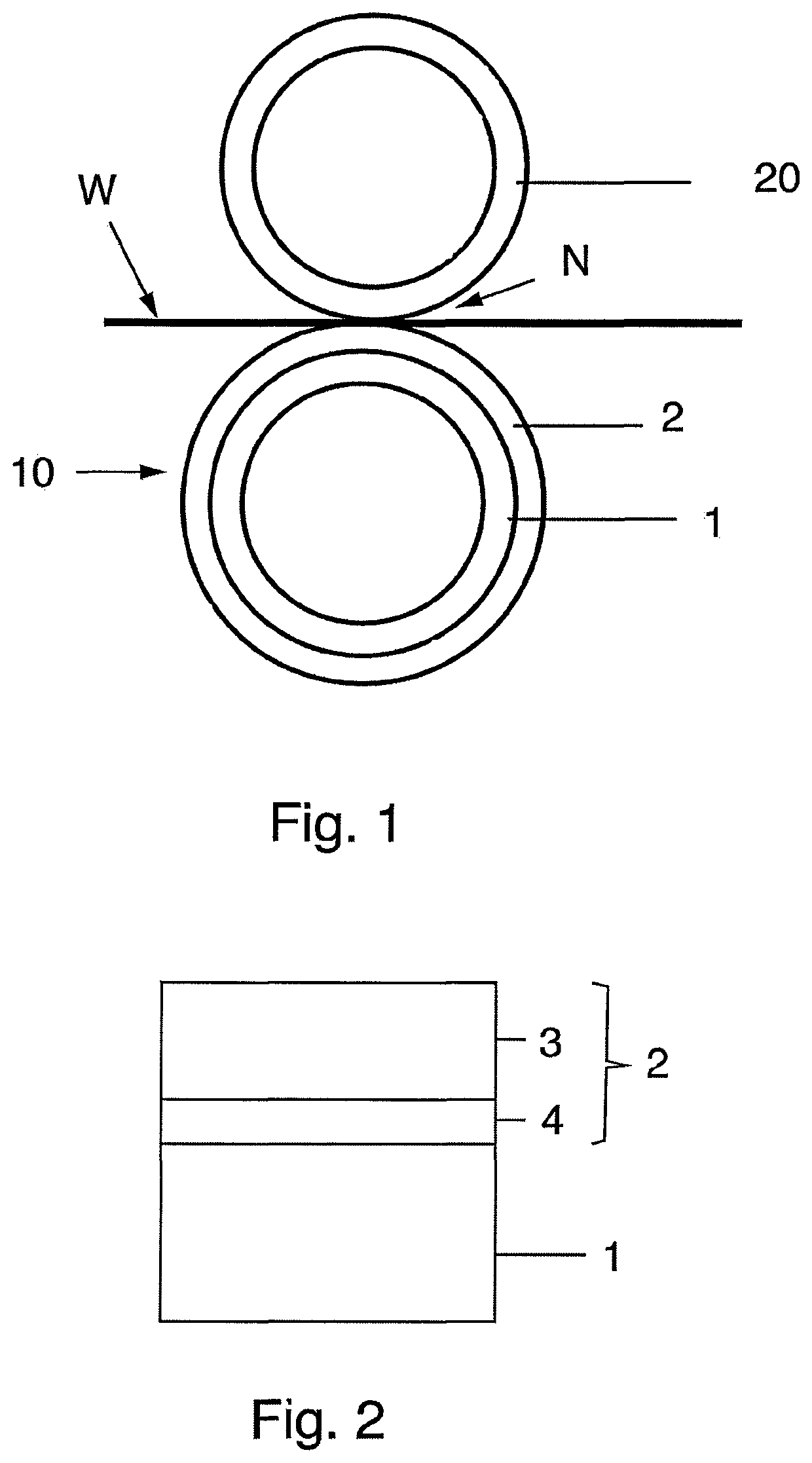Roll and its use
a technology of rolling and rolling pin, applied in the field of rolling pin, can solve the problems of reducing some other properties, coming into contact with a fast moving surface, and high exposure of the rolling surface,
- Summary
- Abstract
- Description
- Claims
- Application Information
AI Technical Summary
Benefits of technology
Problems solved by technology
Method used
Image
Examples
examples 1-3
[0051]Three samples simulating calender roll covers were prepared. A resin composition comprising bisphenol-F epoxy resin, diethyl toluene diamine hardener and a filler was made. The resin composition was the same in all examples 1-3, only the filler type was varied as shown in Table 1.
[0052]Example 1 represents an embodiment according to the invention, while examples 2 and 3 represent comparative embodiments. In Example 1 the used filler comprised hollow aluminium oxide spheres having particle size of 5-40 μm (supplied by Kit-Stroy SPb, Russia). In Comparative Example 2 the used filler comprised silica having a D50 particle size of 3 μm (supplied by Sibelco, Finland) and in Comparative Example 3 the used filler comprised silicon carbide having a D50 particle size of 3 μm (supplied by Saint-Gobain).
[0053]Each resin composition thus obtained was applied to aramide fiber sheet and laminate plates with thickness of 12 mm was built. The laminate plates were cured at a temperature of 150...
examples 4-5
[0054]Examples 4-5 compare the effect of material and hardness of the microsphere filler in a composite. Epoxy composition comprising bisphenol A epoxy resin, diethyl toluene diamine hardener and filler was applied on aramid fiber sheets in a similar way as described in examples 1-3.
[0055]Example 4 represents an embodiment according to the invention while Example 5 represents a comparative example. The laminate plate in Example 4 contains 25 w-% hollow aluminium oxide spheres with a particle size of 5-40 μm (supplied by Kit-Stroy SPb, Russia). In Example 5 the hollow aluminium oxide spheres of Example 4 were replaced with the same amount of alkali aluminosilicate microspheres having a D50 particle size of 5 μm and hardness of 7 Mohs Scale (supplied by 3M).
[0056]Surprisingly it was found that Example 4, i.e. an embodiment according to the invention, gave better performance over the comparative Example 5 for all tested properties. Thus, it may be assumed without wishing to be bound by...
examples 6-8
[0057]Three samples simulating a sizer roll cover were prepared. A polyurethane composition was made by mixing PPDI-terminated polyether prepolymer, an amine hardener and a filler. The polyurethane composition was the same in all examples 6-8, only the filler type was varied as shown in Table 1.
[0058]Example 6 represents a comparative example, while Example 7 and Example 8 represent embodiments according to the invention. In comparative Example 6 the filler was calcined alumina with particle size of 3 μm (supplied by Almatis). In Examples 7 and 8 the calcined alumina filler of Example 6 was replaced by hollow aluminium oxide spheres having particle size of 5-40 μm (supplied by Kit-Stroy SPb, Russia). The obtained resin compositions with filler were mold-cast and post-cured at 130° C. for 20 hours. The wear test was performed as a rubber wheel wear test slightly modified from ASTM G65 giving material loss as mm3 / Nm. The measured value for the comparative test is given as an absolute ...
PUM
| Property | Measurement | Unit |
|---|---|---|
| particle size | aaaaa | aaaaa |
| thickness | aaaaa | aaaaa |
| particle size | aaaaa | aaaaa |
Abstract
Description
Claims
Application Information
 Login to View More
Login to View More - R&D
- Intellectual Property
- Life Sciences
- Materials
- Tech Scout
- Unparalleled Data Quality
- Higher Quality Content
- 60% Fewer Hallucinations
Browse by: Latest US Patents, China's latest patents, Technical Efficacy Thesaurus, Application Domain, Technology Topic, Popular Technical Reports.
© 2025 PatSnap. All rights reserved.Legal|Privacy policy|Modern Slavery Act Transparency Statement|Sitemap|About US| Contact US: help@patsnap.com

